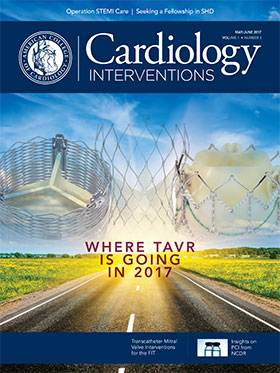Transcatheter Mitral Valve Interventions: An Introduction for the FIT
For patients at elevated surgical risk, there has been rapid advancement in catheter-based technologies to treat valvular heart disease in the past five years. As compared with aortic valve disease, there are numerous challenges to repair or replace the mitral valve through dedicated transcatheter technology. The mitral apparatus is complex, changes geometrically during a single cardiac cycle and is subject to higher closing pressures. There is also a lack of a reliable native annular ‘anchor’ to hold a non-surgical mitral valve in place. The etiologies for mitral pathology can be at the level of the leaflet, the annulus or chordae. Given these anatomical and pathophysiologic considerations, it is important for the fellow in training to consider the current commercially available devices in the context of the emerging challenges ahead.
 |
First off, it is important to recognize that the MitraClip system (for mitral valve repair) is only approved by the U. S. Food and Drug Administration (FDA) for primary (degenerative) mitral regurgitation (MR) in prohibitive-risk surgical candidates. This includes patients with flail scallops/leaflets, calcific degeneration or restricted leaflets. It is true that the EVEREST II trial included patients with functional MR (normal mitral valve with regurgitation due to dilatation of the left ventricle). However, ‘functional’ was not included in the FDA approval as uncertainty remained about the long-term benefit of the procedure, especially as it does not address the underlying left ventricular pathology, which is a more frequent cause of future morbidity than MR.1
As a result, patients who have functional MR who are being considered for MitraClip would need to be enrolled in the COAPT study, a 1:1 randomized study evaluating the MitraClip versus medical therapy.2 To date, enrollment has been slow for COAPT. The inclusion criteria for COAPT require optimal medical therapy with no medication changes for 30 days. While patients with mixed MR, with both functional and degenerative components, might be considered for on-label use outside of a clinical trial, this indication is often controversial.
The Edwards Sapien 3 valve, designed for aortic use, has been successfully used off-label for transcatheter mitral valve replacement (TMVR), often using a transeptal antegrade technique or transapical retrograde approach. This technique has been used most commonly in degenerated mitral bioprostheses (valve-in-valve) and degenerated valve repairs (valve-in-ring).3 Less commonly, a Sapien 3 valve can be used to replace a native mitral valve.4 These cases rely on circumferential mitral annular calcification (MAC) to anchor the valve in place.
As an important corollary to TMVR, the potential for left ventricular outflow tract (LVOT) obstruction with a new valve is a paramount consideration.5 Valve-in-valve, valve-in-ring and valve-in-MAC procedures are at increasing degrees of LVOT obstruction from a new valve. The general pathophysiology involves the shifting of redundant native anterior leaflet of the mitral valve obstructing outflow from the left ventricle.6 Valve-in-valve cases are certainly at the lower risk of LVOT obstruction from TMVR as compared with valve-in-ring and valve-in-MAC procedures. However, valve-in-valve procedures with hypertrophied ventricles can still pose a risk of LVOT obstruction from prosthetic leaflet tissue. Several institutions have created 3D modeling software to assess this risk and model the ‘neo-LVOT’ area post valve replacement.7 This modeling has been instrumental to the safety of TMVR.
In cases where there is predicted LVOT obstruction with TMVR, several techniques have been reported to modify this risk. Emergent alcohol septal ablation has been reported as a bail-out technique in the setting of severe rise in LVOT gradient post TMVR.8,9 An emerging area of investigation is pre-emptive alcohol septal ablation and waiting four to six weeks for myocardial remodeling. These patients can then be re-imaged to again model the ‘neo-LVOT’ area prior to TMVR. This may be a preferred approach for valve-in-valve TMVR in patients at high risk for LVOT obstruction.
Another novel technique is called the LAMPOON (Intentional Laceration of the Anterior Mitral Valve Leaflet to Prevent Left Ventricular Outflow tract ObstructioN). This is a percutaneous method to longitudinally lacerate the anterior mitral leaflet at A2 during TMVR. Particularly in valve-in-ring and valve-in-MAC, this procedure has been technically successful in an animal model and in humans to reduce LVOT obstruction risk.10,11 A study directed by the National Heart, Lung, and Blood Institute will start enrollment soon to evaluate the safety of the LAMPOON technique in transcatheter MVR.12
At this time, MitraClip and off-label Edwards Sapien 3 valves are the only commercially available therapies to treat either primary degenerative MR or degenerative surgical prostheses. For those with mitral valve pathologies outside of the above, such as functional etiologies or even degenerative valves that may be poor MitraClip anatomical substrates, there are several investigational studies ongoing for the Tendyne (acquired by Abbott) and Tiara (Neovasc Inc) valves. Tendyne and Tiara are both transapical valves with large delivery sheaths. Both valves are self-expanding with D-shaped configurations. Given the large delivery systems, there may be similar concerns for morbidity with transapical access as there has been for transcatheter aortic valve replacement.13,14
In summary, transcatheter mitral valve interventions are in their infancy. Our understanding of the physiology of the mitral apparatus is evolving through our experiences with current technology. There are multiple anatomic, pathophysiologic and patient considerations that are necessary to match the right patient to the appropriate therapeutic approach that will serve as the most durable option to treat their mitral valve disease.
References
- Feldman T, Foster E, Glower DD, et al. N Engl J Med 2011;364:1395-406.
- Cardiovascular Outcomes Assessment of the MitraClip Percutaneous Therapy for Heart Failure Patients With Functional Mitral Regurgitation (The COAPT Trial). Available at: https://clinicaltrials.gov/ct2/show/NCT01626079. Accessed May 12, 2017.
- Webb JG, Wood DA, Ye J, et al. Circulation 2010;121:1848-57.
- Guerrero M, Dvir D, Himbert D, et al. JACC Cardiovasc Interv 2016;9:1361-71.
- Blanke P, Naoum C, Dvir D, et al. JACC Cardiovasc Imaging 2017;10:482-5.
- Greenbaum AB, Condado JF, Eng M, et al. Catheter Cardiovasc Interv 2017;May 4:[Epub ahead of print].
- Wang DD, Eng M, Greenbaum A, et al. JACC Cardiovasc Imaging 2016;9:1349-52.
- Deharo P, Urena M, Himbert D, et al. JACC Cardiovasc Interv 2016;9:e73-e6.
- Guerrero M, Wang DD, Himbert D, et al. Catheter Cardiovasc Interv 2017;Mar 7:[Epub ahead of print].
- Khan JM, Rogers T, Schenke WH, et al. JACC Cardiovasc Interv 2016;9:1835-43.
- Babaliaros VC, Greenbaum AB, Khan JM, et al. JACC Cardiovasc Interv 2017;10:798-809.
- NHLBI DIR LAMPOON Study: Intentional Laceration of the Anterior Mitral Leaflet to Prevent Left Ventricular Outflow Tract Obstruction During Transcatheter Mitral Valve Implantation. Available at: https://clinicaltrials.gov/ct2/show/NCT03015194?term=LAMPOON+Study&rank=1. Accessed May 12, 2017.
- Reynolds MR, Magnuson EA, Lei Y, et al. J Am Coll Cardiol 2012;60:2683-92.
- Leon MB, Smith CR, Mack MJ, et al. N Engl J Med 2016;374:1609-20.
 |
|
| Click the cover image above to read the latest issue of Cardiology: Interventions in e-pub format or click here to read it on the web! | |
Clinical Topics: Cardiac Surgery, Congenital Heart Disease and Pediatric Cardiology, Invasive Cardiovascular Angiography and Intervention, Valvular Heart Disease, Aortic Surgery, Cardiac Surgery and CHD and Pediatrics, Cardiac Surgery and VHD, Congenital Heart Disease, CHD and Pediatrics and Interventions, CHD and Pediatrics and Quality Improvement, Interventions and Structural Heart Disease
Keywords: Cardiology Interventions, Aortic Valve, Cardiac Catheterization, Heart Defects, Congenital, Heart Valve Diseases, Mitral Valve, Registries, Transcatheter Aortic Valve Replacement
< Back to Listings
